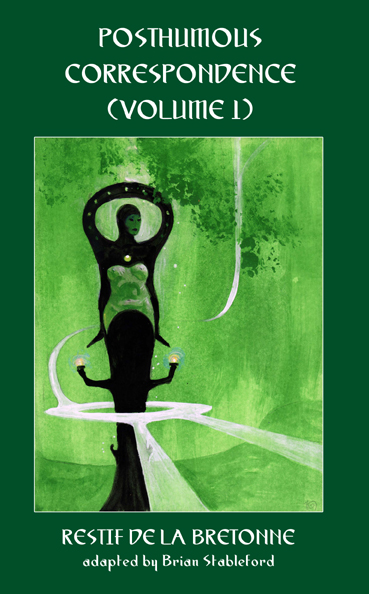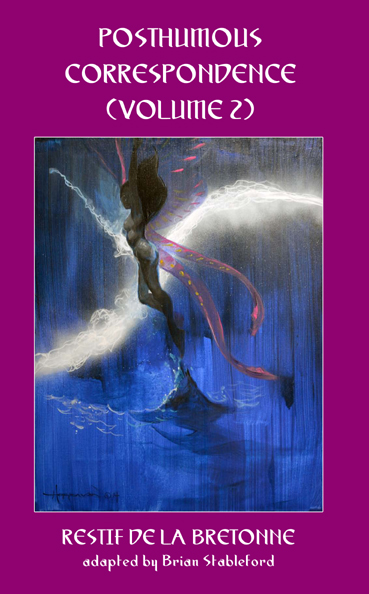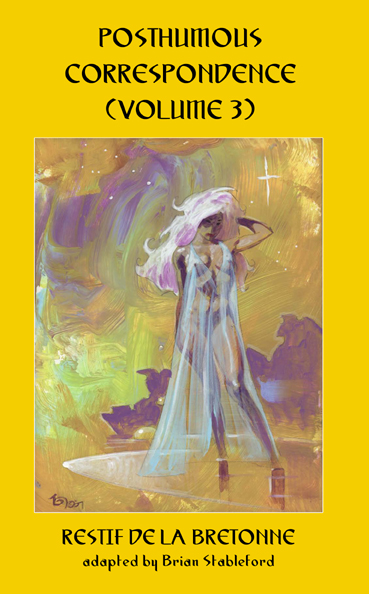Review by Glenn Russell
"My aim, in the composition
of this extraordinary work, is the same as that of Pythagoras on his arrival
in Italy, to cure humans of the vain fear of death, a fear tripled or
multiplied a hundredfold by Christianity." from the Preface
to his Posthumous Correspondence - Réstif de la Bretonne
Réstif de la Bretonne
(1734-1806), French novelist and essayist, author of nearly two hundred
books on a vast number of subjects, a writer frequently associated with
four fun facts: Réstif’s 1769 treatise on prostitution, Le
Pornographe, is where we get the word pornography; his term retifism
for shoe fetishism was named after him; he continually pushed the envelope
on obscenity to test the limits of censorship; and, how he and the Marquis
de Sade maintained a mutual hatred (unlike de Sade, Rétif viewed
sex as a splendid opportunity to bring great pleasure and delight to oneself
and one’s partner). What an innovative thinker and writer.
Black Coat Press has done a
great service in making six Réstif de la Bretonne books available
to English readers, including Posthumous Correspondence in three
separate volumes. Regarding Volume 1, the book under review, translator/adapter
Brian Stableford outlines in his twenty page Introduction, the
historic and cultural context of de la Bretonne’s work, addressing
how the prolific French author maintained quite “modern” views
not only respecting morals but even recognizing, many years prior to Charles
Darwin, the significance of evolutionary theory, integrating his unique
understanding and interpretation of the evolution of various species throughout
the cosmos into his fictionalized accounts.
As Mr. Stableford notes and
I came to appreciate, the format of Posthumous Correspondence provided
the author broad license to fantasize to his heart’s content, shifting
focus as he explored death as so many spectacular wonderlands of opportunity.
And what exactly is the format of this one-of-a-kind work of the imagination?
Answer: a series of letters exchanged between Monsieur de Fontlhète
and his beloved wife Hortense.
In this first volume, Monsieur
makes contact with Yfflasie and Clarendon, a husband and wife who are
now souls without a body since they were victims of a tragic death at
the point of orgasm on their wedding night. Fontlhète learns of
their many and varied adventures in the afterlife and conveys all the
fabulous details to Hortense. As a way of sharing a taste of the contents,
here are several highlights:
Monsieur de Fontlhète
informs Hortense how she has a foretaste of the perfect happiness awaiting
us all after the removal of our bondage to the body: pleasant dreams!
As we read in the Preface to this three volume work, the prime
motivation for the author in setting pen to paper in the first place was
to cure humans of the fear of death, a fear multiplied by the prevalent
Christian religion. Even in the twentieth century, far removed from the
days of Restif de la Bretonne, in my boyhood, when I myself listened to
or read about souls being tormented in the fires of hell, I sensed there
was something disturbing, even sadistic, about such tales. And the last
time I heard a buffoonish bigmouth jabbering about men and women not sharing
his faith ultimately burning in hell, I reflected that he was at least
consistent, since, in many other ways, he had a pronounced sadistic streak.
Three direct quotes where Fontlhète
means to lift the spirits of his Hortense: “I shall prepare stories,
such as have never been written, because no one has had the opportunity
to return to the Source, as I am doing.” “The soul is immortal
since it is divine; it will live; it will remember; it will love those
it loves.” “Yfflasie and Clarendon had just expired, while embracing.
Even Destiny can never separate those who die thus, in the blossoming
expansion of amour and procreation: it is the greatest of joys . . . And
they united themselves again, with an inexpressible sentiment of tenderness
and wellbeing.” As Fontlhète wishes to lift the spirits of
Hortense, so Restif de la Bretonne desires to lift the spirits of his
readers. I can assure you, all one hundred letters composed by Fontlhète
along with Hortense’s response to each letter make for an exhilarating
read.
Fontlhète goes into
exquisite detail involving the journeys of Yffflais and Clarendon. “They
traveled the globe. They wanted to see all the continents and all the
islands. What voluptuousness! They visited the Earth with more facility
than a Parisian bourgeois measures his sandy little garden, planted with
four lindens in a fan, a lilac and two rose-bushes. They obtained an accurate
idea of all nations.” And not only lands, the two lovers have occasion
to meet and speak with the likes of Louis XIII and Louis XIV, Voltaire
and Molière and many other notables, learning all sorts of provocative
tidbits revolving around the rich and famous and what they are all up
to as discorporated souls.
According to Fontlhète,
our earthy sphere mirrors the incorporeal world, that everything we experience
as humans is an imitation of its higher equivalent. Do I hear echoes of
Plato and Plotinus? Again, all of Fontlhète’s words are made
in an effort to remove any feelings of fear or dread we might hold when
it comes to death. To underscore the pleasure one will experience after
our corporal existence, Fontlhète goes so far as to say: “How
mistaken Homer is in assuring us that the estate of souls is so miserable,
and that they continually regret their bodies; that idea is immoral, destructive
of virtue and courage, and contrary to the truth.”
Toward the end of Volume
One, Fontlhète proclaims: “I semi-discorporated myself
yesterday, in order to see the continuation of the souls, but alas, man
proposes and God disposes; I found myself a winged man, not by means of
the graundy invented by the English but with artificial and mechanical
wings having a rapid movement of those of the butterflies that one sees
in summer sucking from flowers without ever resting or alighting.”
And our letter writer resolves to use his wings and newfound powers for
the well-being and benefit of the world. In other words, we have the forerunner
of all those familiar comic book flying superheroes who work for truth
and justice and battle against the forces of evil. Restif de la Bretonne
picks up on this superhero theme as he continues his Posthumous Correspondence
in Volume 2. I highly recommend you join the adventure and let
your imagination soar.
|




